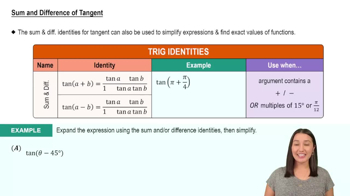Textbook Question
In Exercises 35–38, find the exact value of the following under the given conditions:d. sin 2α3 𝝅 12 𝝅 sin α = ------- , 0 < α < -------- , and sin β = --------- , --------- < β < 𝝅. 5 2 13 2
831
views
 Verified step by step guidance
Verified step by step guidance Verified video answer for a similar problem:
Verified video answer for a similar problem:



 6:14m
6:14mMaster Sum and Difference of Sine & Cosine with a bite sized video explanation from Patrick
Start learning